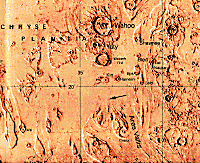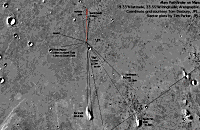


The image shown above left gives the approximate landing site (arrow) of the Mars Pathfinder in Ares Vallis. The landing point is estimated to be at 19.33 N, 33.55 W. North is up in this image, which is part of Viking 1 Orbiter frame 004A27. The large crater closest to the landing site is about 1.5 km in diameter. The image at top right shows the landing site with lines to some of the landmarks seen in the panoramas. A close-up view of the site (650 K) showing more of the sighting points is available. Below that is part of the Oxia Palus USGS shaded relief map showing the landing site and surrounding crater names. A full-resolution version of the landing site image without the arrow shown above left is also available. Below are a global view with the arrow pointing to the landing site in Ares Vallis and a wide-area view of the landing site.
Original description of the landing site:
NASA has selected an ancient flood plain on Mars as the landing site for the 1996 mission of Mars Pathfinder, one of the first in a new generation of small, low-cost spacecraft. Eons ago, when water flowed on Mars, great floods inundated the landing site, located on a rocky plain in an area known today as Ares Vallis. The site is 850 kilometers (527 miles) southeast of the location of Viking Lander 1, which in 1976 became the first spacecraft to land on Mars. Pathfinder will be the first to land on Mars since the twin Viking landers arrived almost 20 years ago. The spacecraft, scheduled to arrive at Mars on July 4, 1997, will parachute down to Ares Vallis at the mouth of an ancient outflow channel chosen for the variety of rock and soil samples it may present. The target landing site, at the center of the landing ellipse pictured below, is 19.5 N, 32.8 W.
The purpose of the new Pathfinder mission is to demonstrate an inexpensive system for cruise, entry, descent and landing on Mars, said Project Manager Anthony Spear and Project Scientist Dr. Matthew Golombek of NASA's Jet Propulsion Laboratory. The lander, carrying the microrover, will aerobrake in the upper Martian atmosphere using an aeroshell and a parachute. Just before impact, airbags will inflate to cushion the landing. The microrover will then roll out to examine the rocks and soil nearby. Both lander and rover will carry scientific instruments and cameras. The lander will make atmospheric and meteorological observations during descent and function as a weather station on the surface, as well as a radio relay station for the rover. The constraints on the location have to do with engineering considerations, Spear said. Since the spacecraft are solar-powered, the best site is one with maximum sunshine and in July, 1997, the sun will be directly over the 15 degrees north latitude region of the planet. The elevation must be as low as possible, Spear added, so the descent parachute has sufficient time to open and slow the lander to the correct terminal velocity. The landing will be within a 100- by 200-kilometer (60- by 120-mile) ellipse around the targeted site due to uncertainties in navigation and atmospheric entry.
Ares Vallis, which meets the engineering constraints, was chosen after a workshop earlier this year that involved the invited participation of the entire scientific community concerned with Mars. More than 60 scientists from the United States and Europe attended. The Ares Vallis site is also a "grab bag" location, according to Golombek, set at the mouth of a large outflow channel in which a wide variety of rocks are potentially within the reach of the rover. Even though the exact origins of the samples would not be known, he said, the chance of sampling a variety of rocks in a small area could reveal a lot about Mars. The rocks would have been washed down from highlands at a time when floods moved over the surface of Mars. Several potential sites were listed where ancient flood channels emptied into Chryse Planitia, having cut through crustal units and ridged plains where the water would have picked up material and deposited it on the plain. Other sites that were considered included Oxia Palus, a dark highlands region that contains highland crust and dark wind-blown deposits; Maja Valles Fan, a delta fan which drained an outflow channel; and the Maja Highlands, just south of Maja Valles. All of the sites were studied using Viking orbiter data.
Both the Pathfinder lander and rover have stereo imaging systems. The rover, additionally, carries an alpha proton x-ray spectrometer with which it will examine the composition of the rocks. The imaging system will reveal the mineralogy of surface materials as well as the geologic processes and surface-atmosphere interactions that created and modified the surface. The instrument package will also enable scientists to determine dust particle size and water vapor abundance in the atmosphere.
 Mars Pathfinder Page
- information on the mission, Mars, and other resources
Mars Pathfinder Page
- information on the mission, Mars, and other resources Mars global view showing the Viking and Mars Pathfinder landing sites
Mars global view showing the Viking and Mars Pathfinder landing sites Mars Mileage Guide
- distance between Pathfinder and Viking landing sites and other martian features
Mars Mileage Guide
- distance between Pathfinder and Viking landing sites and other martian features Mars Pathfinder Entry Strategy
- the plans for Mars Pathfinder atmospheric entry and landing.
Mars Pathfinder Entry Strategy
- the plans for Mars Pathfinder atmospheric entry and landing. NSSDCA Planetary Page
NSSDCA Planetary Page Author/Curator:
Author/Curator: